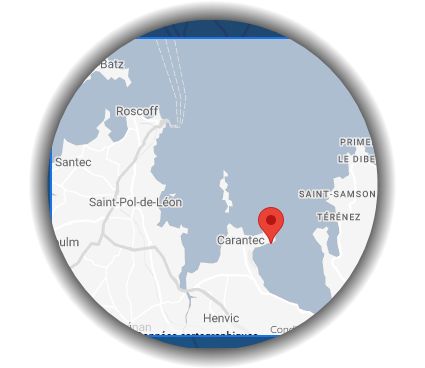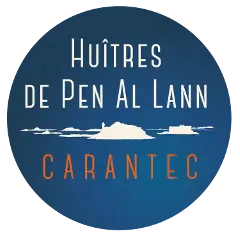Representative of the 4th generation of Établissements Berder in Carantec, Gireg Berder took over the reins of the oyster farm at Pointe de Pen Al Lann in 2020. In a few paragraphs, here are his convictions and the commitment of the farm in terms of breeding, product quality and good practices with a view to limiting the environmental impact of an activity that is intended to be as sustainable as possible.
Land farming in Morlaix Bay
Pen Al Lann oysters are placed directly on the sandy bottom of our parks. The low breeding density in an open space and the presence of red algae guarantee them an exceptional nutritional intake and give them this wild oyster character . This traditional breeding method is still only maintained by a few oyster farmers in Brittany .
Depending on the refinement we wish to give them, after 3 years, the oysters will finish their breeding in different parks around the Pen Al Lann peninsula in Carantec.

The oysters will then acquire the typicality that the sea currents and the ecosystem of each park in the bay will give them:
- " Tarzellou ", in deep waters off the Pointe de Pen Al Lann, on sand in strong currents, and associated with red algae such as Dulse or cryptopleura, Porphyra, will have a significant supply of food. The oysters will develop a higher rate of flesh there, providing a great length in the mouth, sweet and buttery.
- " Roc'h Glaz ", on the foreshore, on a sandy bottom. More sheltered in the western cove of the Bay, the oysters will develop a finer and more iodized flesh.
- " Barnenez ", in deep waters, off the coast of Pointe de Barnenez and Sterec Island, therefore more likely to have larger oysters: subjected to the remains of the swell on a sandy bottom, the oysters will develop a solid shell and firm flesh that lasts a long time in the mouth.
Quality Activist
At the end of 2023, the Berder oyster farm wanted to get a little more involved in promoting and enhancing our historic and traditional soil farming method , convinced that this method is part of a quality approach for our consumers .
Berder Establishments Member of the Culinary College of France
We therefore wanted to join the collective of the Culinary College of France . We had the honor and pride of being selected.
This commitment also reflects our desire to make our oyster farming profession part of a sustainable activity where we pay close attention to our environmental impact and are attentive to the role of our company at the local level.
Learn more about the Culinary College of France collective
The Morlaix Bay Oyster Association
The Bay of Morlaix, particularly Carantec, constitutes the largest oyster basin in Finistère and the second largest in Northern Brittany after Paimpol.
In 2023, we co-founded the association “ L'Huître de la Baie de Morlaix ”.
Aware of the historic place of oyster farming in the Bay of Morlaix and the role of this activity in the territory but also in the whole of the Brittany region, we wanted this association to be one of the vectors of promotion of the Bay of Morlaix, its economy, its ecosystem and its population.
It therefore pursues several objectives which are the very object of the association:
- the promotion of oysters from the Bay of Morlaix-Penzé,
- maintaining the memory of oyster farming, of which Morlaix Bay is one of the Breton cradles
- awareness of the ecosystem and environmental changes of which oyster farming is one of the first witnesses
- the democratization of scientific knowledge of oyster farming
- the federation of local stakeholders (professionals, associations, communities, institutions, schools) for the promotion of the Morlaix Bay Oyster, and more broadly of its territory
- the opening and strengthening of the attractiveness of the oyster world
- the promotion of oyster, cultural, artistic, gastronomic, sporting and scientific heritage linked to the Oyster in Morlaix Bay
The association thus organized the first edition of the Carantec Oyster Festival in April 2023. This biennial event will be repeated in 2025 around historical themes: technical, cultural, artistic, gastronomic, sporting, educational and scientific linked to oyster farming and the Bay.
Learn more about the association and the Carantec Oyster Festival
Environmental impact and preservation of the ecosystem of Morlaix Bay
Aware of the influence of human activities on our ecosystem, we pay constant attention to our environmental impact.
The oyster farming cycle
We aim to ensure that our oysters travel as few kilometres as possible between birth and sale. We have therefore chosen to capture in the Rade de Brest and continue their breeding in Carantec in the Bay of Morlaix. Thus, at the time of their harvest, they travel 60 km and are re-sown in 24 hours instead of several hundred kilometres and several days out of water when they are purchased on the Atlantic coast.
Then, our oysters will grow and be worked for 3 years in Morlaix Bay in a perimeter which will not exceed 5 kilometers around the site.
We are convinced that beyond improving the carbon footprint of our activity, this constant attention benefits the quality of our oysters for our customers.
Empty shells
We reuse all empty oyster shells from our activities (farming, tasting) in biodegradable burlap bags that are used to maintain the dams of our ground oyster farms. We encourage our customers to bring us their empty shells.
The decomposition over time of these oyster shells will make calcium carbonate available again for the constitution of the shells of shellfish including our oysters and helps to deacidify the sea . A virtuous loop to preserve this natural cycle.
Waste management
We raise awareness among each of our employees about the waste management that our activity generates, like any human activity. We pay attention to sorting and collecting waste at sea from professionals and individuals. We therefore participate, as citizens, in the recovery of materials and their reuse.
Preserving the ecosystem in Morlaix Bay
We raise our oysters in decades-old oyster farms , maintained by past generations and some within our company for 80 years. Each of our farms is known for the different contribution it will have on the oysters, in particular thanks to the ecosystem it shelters or that surrounds it.
Thus, the interactions between oysters on the ground and the protected red algae and eelgrass beds that border some of our deep-water parks are an example of reciprocal interspecies benefits: the oysters filter the surrounding water, which promotes its clarity and improves the photosynthesis of these plants and therefore the oxygenation of the water. A virtuous loop.




